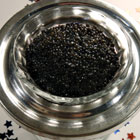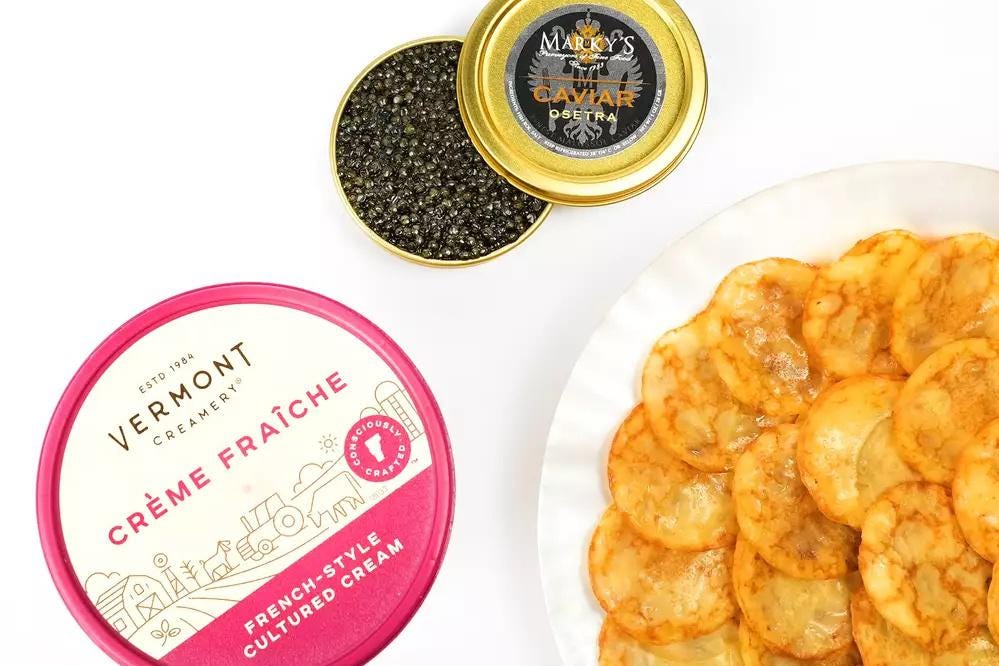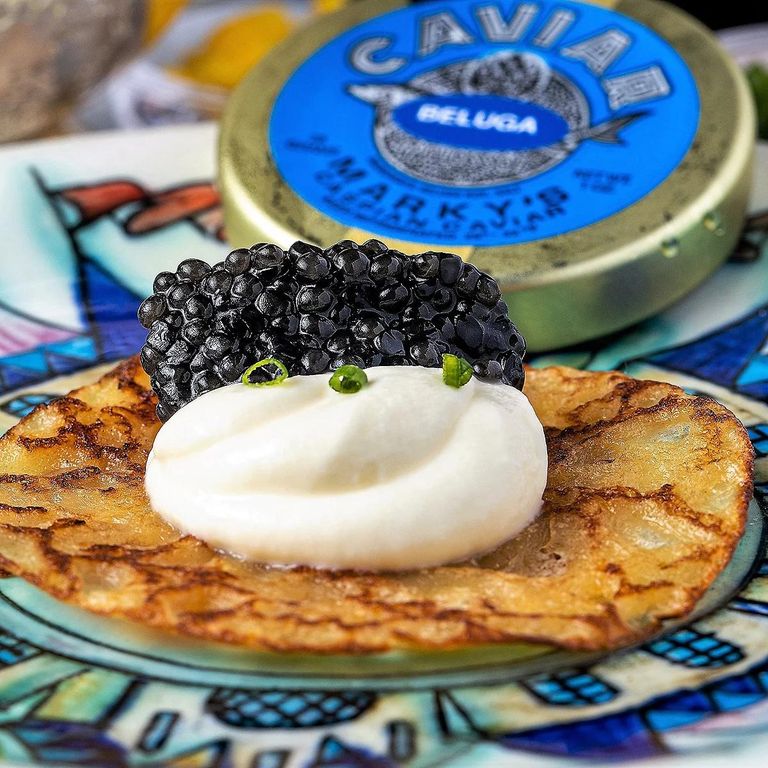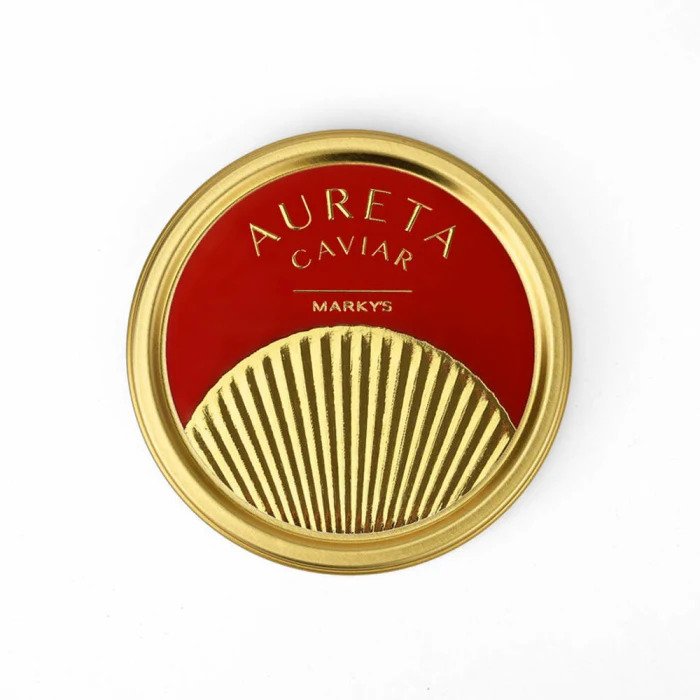Domestic Caviar - American white sturgeon caviar, paddlefish roe online
Category : Press Room |
Posted : Dec 24, 2003
RED WHITE & BELUGA
American Caviar
December 24, 2003
By Ramin Ganeshram
Ramin Ganeshram is a freelance writer.

American caviar (Newsday Photo/Tony Jerpme)
For holiday revelers seeking a bit of luxury, the prized catches this season are Iranian osetra and a relative newcomer to the caviar market - transmontanous.
Though exotic-sounding, the newcomer has humble roots for a caviar. It is domestic, harvested from American white sturgeon, or transmontanous sturgeon, that are farmed in freshwater tanks in California and elsewhere in the United States. It's close to Russian and Iranian osetra in flavor and appearance.
After eight years on the market, American sturgeon caviar is getting its due, becoming an acceptable - and to environmentally concerned connoisseurs, a preferable - alternative to threatened Caspian Sea caviars, particularly beluga. It's also half the price of the best beluga, in some cases.
"This year we chose not to sell beluga caviar because it is most endangered," said Mark Russ Federman, owner of Russ & Daughters in lower Manhattan. But he did start selling American sturgeon caviar for the first time, because it has become "very good, the best year I've seen."
At Petrossian, a leading purveyor of all caviars in Manhattan and Paris, executive director Eve Vega said their sales this year of the transmontanous are already going off the charts.
Stolt Sea Farm in Sacramento County, just one of the handful of U.S. caviar producers and the supplier of Petrossian's transmontanous, will harvest nearly 9,000 pounds of caviar, almost three times the amount harvested in 1999. Stolt's sales have doubled yearly since 2001.
Tsar Nicoulai of San Francisco, the first company to farm white sturgeon some 20 years ago, now owns 8 million pounds of fish and expects to produce 25,000 pounds of caviar a year in five years.
The term caviar refers to the salted roe, or eggs, of fish in the sturgeon family, and until recently connoisseurs insisted that it specifically referred only to eggs from Caspian Sea sturgeon that produced the sevruga, osetra and beluga varieties. Of the 27 species of sturgeon, seven are native to the United States. The rest live in the Caspian Sea and bodies of water in Central Asia.
The American caviar industry has experienced a boom in response to limited or poor product coming out of the Caspian Sea, where the bulk of caviar is harvested by Russia and Iran and where overfishing in the 1990s placed sturgeon fisheries in peril.
The industry has also benefited from the support of Sea Web's Caviar Emptor, a nonprofit ocean preservation group that has lobbied the U.S. Fish and Wildlife Service to place beluga sturgeon, the most imperiled sturgeon fishery, on an endangered species list. A decision is expected next month and, if adopted, the measures would prevent importation of beluga caviar into the United States, buyer of 60 percent of the world's beluga caviar stores.
Some retailers have voluntarily stopped selling beluga and osetra. Four years ago, natural and organic food retailer Whole Foods Markets, which has stores in Manhasset and Manhattan, made the switch to exclusively sell farmed domestic caviar to take pressure off the Caspian Sea caviar industry.
On top of the environmental concerns, sources say the American stuff has improved. Previously farm-raised American caviar wasn't always up to par, said Hossein Aimani, president of Paramount, a caviar importer in Long Island City, because American producers didn't have centuries of knowledge about how to process caviar.
Once an egg sac is removed from a still- living or freshly killed sturgeon it is strained three times to produce clean eggs. The eggs are then salted at a measure of 50 grams of salt per 1,000 grams of eggs to create "malossol" or "lightly salted" caviar.
"American producers would over salt or under salt or harvest improperly and the product was inferior. That has all changed and now there are some wonderful American caviar and roe products out there," Aimani said.
Additionally, the industry had to overcome bad initial press in the 1990s surrounding domestic fish roes from paddlefish and hackleback marketed to the public as "caviar." These were, in fact, entirely different products with a taste often characterized as "muddy."
"When we started producing caviar from white sturgeon, which has characteristics most similar to both osetra and beluga in terms of quality, appearance and taste, we had a great-tasting, high-end product fighting an initial bad impression," said Chuck Edwards, sales and marketing manger for Stolt. "While we are enjoying an increasing following among chefs, there are still those that don't want to have anything to do with it."
The strong support of many chefs is, in fact, rapidly bolstering the new American caviar market.
"I have always served Caspian caviars my whole career, which I would select by blind tasting," said chef Rick Moonen of the Manhattan seafood eatery rm. "About two years ago I found that the beluga caviars were inferior-tasting and not worth the price. On the other hand I tasted some American caviars and was impressed. I made the decision to switch permanently when I learned about [beluga sturgeon's] endangered situation."
"You try to have an environmental thought process when you are buying food, but then it is difficult because you need to give customers a good product and the luxury they expect," said Marcus Samuelsson, executive chef at Aquavit in Manhattan, who uses American caviar. It is a hard balance the chef must make, Samuelsson said, and one he often has been able to reach with American caviar.
But can domestic American caviar ever be as good as those crown jewels of the Caspian Sea?
"It is different but not as different as you think it is. I have had bad caviar from Russia, too, and without any question, American caviar has made great strides," said chef Jaques Pepin, who supports halting international trade in beluga until the fishery is restored and environmental impact of pollution is reversed.
"Caviars like Sterling or Tsar Nicoulai [brands] are certainly excellent, and salmon or rainbow trout roe can be very good at certain times of the year as well," Pepin said.
Pepin said that American roes or caviars are a good way for non-connoisseurs to "ease" in and develop a palate for the better stuff. While Caspian Sea caviars are priced in the $150 to $165 range for about 2 ounces of Beluga, $120 for the same amount of osetra, and $100 for sevruga, high-quality American white sturgeon caviar sells in the range of $65 to $85 for 2 ounces. Paddlefish, hackleback, white fish and salmon roes can be had for less than half that amount.
Still, while chefs such as Moonen serve domestic caviar a la carte, others, including Doug Gulija, chef-owner of Plaza Café in Southampton, use it as a garnish or secondary ingredient because they still don't think it is up to the quality of good Russian or Iranian varieties. Gulija doesn't serve Caspian Sea varieties any longer because of environmental concerns.
At Nick & Toni's in East Hampton, chef de cuisine Seth Caswell, agrees and sticks with American paddlefish roe, an inexpensive product that works well as a component of a dish.
"I wouldn't serve paddlefish roe to my clients and pass it off as caviar because it's not the luxury product they expect - although it is a good product," he said.
Eve Vega teaches monthly caviar education seminars at the Petrossian Cafe and Boutique in Manhattan, complete with chef demonstrations, as well as a caviar seminar at the New School. She said that American white sturgeon caviar has become a product worthy of the Petrossian brand.
"We would absolutely not be selling it if we did not think it was a superior product," she said of American white sturgeon caviar. "Over the years we have worked with Stolt to create the same processing techniques that are used in the Caspian Sea so we can get the best possible product."
Yet, she said, consumers should be aware that Caspian Sea caviar and farmed American caviar are two different things.
"Transmontanous is a great product in and of itself and shouldn't be compared with Caspian Sea osetra because it is not the same thing," she said. "Plus, we have to face the fact that caviar from the Caspian has that unique taste of those waters and that environment and that is the standard. As good as an American caviar might be, it can't mimic that."
Vega also noted that some producers mislabel transmontanous caviar as "American Osetra" when osetra sturgeon only exist in the Caspian Sea.
However that may soon change.
Marky's Caviar, a Florida-based importer, began bringing in 5-year-old live beluga, osetra, and sevruga from the Caspian Sea last June for farming, giving rise to the possibility of real beluga, osetra and sevruga being produced in the United States. Another shipment of five 10-year-old, 60-pound, 6-foot beluga sturgeon arrived this month, and hopes are that the fish ultimately will produce the "real" McCoy osetra, sevruga and beluga caviars.
They are products that will be a long time in coming. Sturgeon, which can weigh in the thousands of pounds, must be 14 to 20 years old, depending on species, before their eggs can be harvested.
In the meantime, there always is American caviar.
"It has been taking a while for people to believe in the product," Vega said, "but as people come onboard you are going to see a good healthy industry that will eliminate the unnatural strain on the Caspian Sea caviar."
Though exotic-sounding, the newcomer has humble roots for a caviar. It is domestic, harvested from American white sturgeon, or transmontanous sturgeon, that are farmed in freshwater tanks in California and elsewhere in the United States. It's close to Russian and Iranian osetra in flavor and appearance.
After eight years on the market, American sturgeon caviar is getting its due, becoming an acceptable - and to environmentally concerned connoisseurs, a preferable - alternative to threatened Caspian Sea caviars, particularly beluga. It's also half the price of the best beluga, in some cases.
"This year we chose not to sell beluga caviar because it is most endangered," said Mark Russ Federman, owner of Russ & Daughters in lower Manhattan. But he did start selling American sturgeon caviar for the first time, because it has become "very good, the best year I've seen."
At Petrossian, a leading purveyor of all caviars in Manhattan and Paris, executive director Eve Vega said their sales this year of the transmontanous are already going off the charts.
Stolt Sea Farm in Sacramento County, just one of the handful of U.S. caviar producers and the supplier of Petrossian's transmontanous, will harvest nearly 9,000 pounds of caviar, almost three times the amount harvested in 1999. Stolt's sales have doubled yearly since 2001.
Tsar Nicoulai of San Francisco, the first company to farm white sturgeon some 20 years ago, now owns 8 million pounds of fish and expects to produce 25,000 pounds of caviar a year in five years.
The term caviar refers to the salted roe, or eggs, of fish in the sturgeon family, and until recently connoisseurs insisted that it specifically referred only to eggs from Caspian Sea sturgeon that produced the sevruga, osetra and beluga varieties. Of the 27 species of sturgeon, seven are native to the United States. The rest live in the Caspian Sea and bodies of water in Central Asia.
The American caviar industry has experienced a boom in response to limited or poor product coming out of the Caspian Sea, where the bulk of caviar is harvested by Russia and Iran and where overfishing in the 1990s placed sturgeon fisheries in peril.
The industry has also benefited from the support of Sea Web's Caviar Emptor, a nonprofit ocean preservation group that has lobbied the U.S. Fish and Wildlife Service to place beluga sturgeon, the most imperiled sturgeon fishery, on an endangered species list. A decision is expected next month and, if adopted, the measures would prevent importation of beluga caviar into the United States, buyer of 60 percent of the world's beluga caviar stores.
Some retailers have voluntarily stopped selling beluga and osetra. Four years ago, natural and organic food retailer Whole Foods Markets, which has stores in Manhasset and Manhattan, made the switch to exclusively sell farmed domestic caviar to take pressure off the Caspian Sea caviar industry.
On top of the environmental concerns, sources say the American stuff has improved. Previously farm-raised American caviar wasn't always up to par, said Hossein Aimani, president of Paramount, a caviar importer in Long Island City, because American producers didn't have centuries of knowledge about how to process caviar.
Once an egg sac is removed from a still- living or freshly killed sturgeon it is strained three times to produce clean eggs. The eggs are then salted at a measure of 50 grams of salt per 1,000 grams of eggs to create "malossol" or "lightly salted" caviar.
"American producers would over salt or under salt or harvest improperly and the product was inferior. That has all changed and now there are some wonderful American caviar and roe products out there," Aimani said.
Additionally, the industry had to overcome bad initial press in the 1990s surrounding domestic fish roes from paddlefish and hackleback marketed to the public as "caviar." These were, in fact, entirely different products with a taste often characterized as "muddy."
"When we started producing caviar from white sturgeon, which has characteristics most similar to both osetra and beluga in terms of quality, appearance and taste, we had a great-tasting, high-end product fighting an initial bad impression," said Chuck Edwards, sales and marketing manger for Stolt. "While we are enjoying an increasing following among chefs, there are still those that don't want to have anything to do with it."
The strong support of many chefs is, in fact, rapidly bolstering the new American caviar market.
"I have always served Caspian caviars my whole career, which I would select by blind tasting," said chef Rick Moonen of the Manhattan seafood eatery rm. "About two years ago I found that the beluga caviars were inferior-tasting and not worth the price. On the other hand I tasted some American caviars and was impressed. I made the decision to switch permanently when I learned about [beluga sturgeon's] endangered situation."
"You try to have an environmental thought process when you are buying food, but then it is difficult because you need to give customers a good product and the luxury they expect," said Marcus Samuelsson, executive chef at Aquavit in Manhattan, who uses American caviar. It is a hard balance the chef must make, Samuelsson said, and one he often has been able to reach with American caviar.
But can domestic American caviar ever be as good as those crown jewels of the Caspian Sea?
"It is different but not as different as you think it is. I have had bad caviar from Russia, too, and without any question, American caviar has made great strides," said chef Jaques Pepin, who supports halting international trade in beluga until the fishery is restored and environmental impact of pollution is reversed.
"Caviars like Sterling or Tsar Nicoulai [brands] are certainly excellent, and salmon or rainbow trout roe can be very good at certain times of the year as well," Pepin said.
Pepin said that American roes or caviars are a good way for non-connoisseurs to "ease" in and develop a palate for the better stuff. While Caspian Sea caviars are priced in the $150 to $165 range for about 2 ounces of Beluga, $120 for the same amount of osetra, and $100 for sevruga, high-quality American white sturgeon caviar sells in the range of $65 to $85 for 2 ounces. Paddlefish, hackleback, white fish and salmon roes can be had for less than half that amount.
Still, while chefs such as Moonen serve domestic caviar a la carte, others, including Doug Gulija, chef-owner of Plaza Café in Southampton, use it as a garnish or secondary ingredient because they still don't think it is up to the quality of good Russian or Iranian varieties. Gulija doesn't serve Caspian Sea varieties any longer because of environmental concerns.
At Nick & Toni's in East Hampton, chef de cuisine Seth Caswell, agrees and sticks with American paddlefish roe, an inexpensive product that works well as a component of a dish.
"I wouldn't serve paddlefish roe to my clients and pass it off as caviar because it's not the luxury product they expect - although it is a good product," he said.
Eve Vega teaches monthly caviar education seminars at the Petrossian Cafe and Boutique in Manhattan, complete with chef demonstrations, as well as a caviar seminar at the New School. She said that American white sturgeon caviar has become a product worthy of the Petrossian brand.
"We would absolutely not be selling it if we did not think it was a superior product," she said of American white sturgeon caviar. "Over the years we have worked with Stolt to create the same processing techniques that are used in the Caspian Sea so we can get the best possible product."
Yet, she said, consumers should be aware that Caspian Sea caviar and farmed American caviar are two different things.
"Transmontanous is a great product in and of itself and shouldn't be compared with Caspian Sea osetra because it is not the same thing," she said. "Plus, we have to face the fact that caviar from the Caspian has that unique taste of those waters and that environment and that is the standard. As good as an American caviar might be, it can't mimic that."
Vega also noted that some producers mislabel transmontanous caviar as "American Osetra" when osetra sturgeon only exist in the Caspian Sea.
However that may soon change.
Marky's Caviar, a Florida-based importer, began bringing in 5-year-old live beluga, osetra, and sevruga from the Caspian Sea last June for farming, giving rise to the possibility of real beluga, osetra and sevruga being produced in the United States. Another shipment of five 10-year-old, 60-pound, 6-foot beluga sturgeon arrived this month, and hopes are that the fish ultimately will produce the "real" McCoy osetra, sevruga and beluga caviars.
They are products that will be a long time in coming. Sturgeon, which can weigh in the thousands of pounds, must be 14 to 20 years old, depending on species, before their eggs can be harvested.
In the meantime, there always is American caviar.
"It has been taking a while for people to believe in the product," Vega said, "but as people come onboard you are going to see a good healthy industry that will eliminate the unnatural strain on the Caspian Sea caviar."







